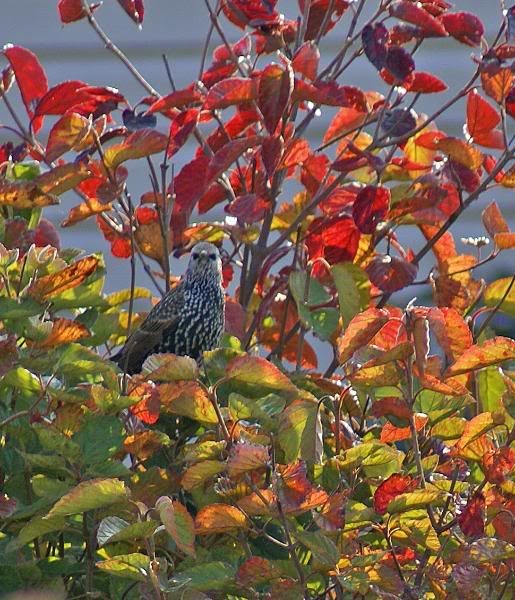
This is really bugging me. I have several bird books and have looked through them all and can't identify this bird. I've never seen it before and have no clue what it is. As I mentioned in the previous post, I didn't even realize that I had taken this picture of it until I was doing the photo editing and saw it. I wish I had picked up that Indiana bird book I looked at yesterday at Barnes and Noble. Can anyone identify this one for me?

10 comments:
I think it might be a flicker. We have Northern Flickers here in Nrn Ca. They have orange under their wings, which you can see when they fly. Very beautiful and unusual looking.
I think it's probably a European Starling. I know we're not supposed to like them - non-native species and all that - but I think they're pretty with the spotted feathers. Check the second picture on the Cornell page for reference.
Entangled, the European starling was the only thing I could come up with too. One of my bird guides only had a picture of the black starling, they look so different that I had ruled it out. After doing a net search on the starling this morning, I think it may be a starling too. I'd never seen the spotted ones before.
Uh, yeah - glad you ignored my comment - I think I was a little tired last night!
Looks like a starling to me, too. And does not look like a flicker. Here's a pic of a flicker for comparison: http://www.birds.cornell.edu/AllAboutBirds
/BirdGuide/Northern_Flicker.html
Note to self: refrain from making comments after dinner! ;)
The Cornell website is great, by the way. We have many many new birds coming through on their way south, and there are so many I haven't seen before. My bird books are just so-so, so thanks for the reference to Cornell!
It is a beautiful photo... with the colorful trees in the background!
Melinda, that's too funny. I know how you feel, I have a habit of posting late at night and sometimes feel that I need to have an internet curfew to protect myself from saying something I shouldn't.
My bird books aren't that great either, but you're right Cornell and other internet sources are much more informative and with better pictures too.
I've tacked a poster of common feeder birds of the Northeast next to my favorite bird-viewing window. According to my poster, that is a European Starling in its winter plumage.
Hi again, Robin :-)
Yes, a European Starling is my suggestion too. Millions are arriving in the UK at the moment to spend the winter here. We had them bring their young into my garden this spring to feed - what a noise they made. In May I took a video of a Juvenile Starling being fed which you might like to see.
They are very socialable birds and we seldom see only one arriving at the feeders here - they usually take over and fight amongst themsleves too. Perhaps it will bring back friends the next time or maybe it is completely lost and quite lonely :-(
This picture immediately reminded me of a raptor.
Pigeon hawk?
Here's another pic of one.
It's a "stupid starling". They are invasive, eat all the bird seed and the suet, chase away the song birds and poop all over the place.
Post a Comment